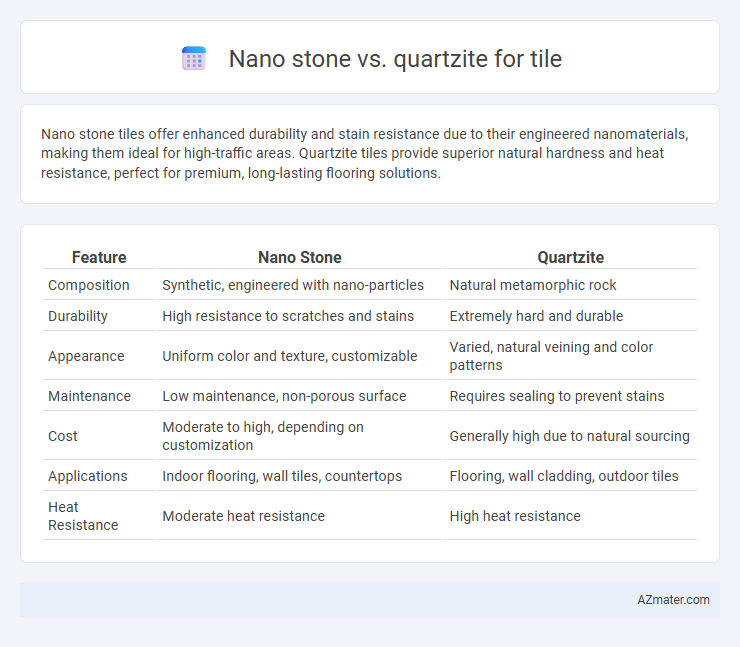Nano stone tiles offer enhanced durability and stain resistance due to their engineered nanomaterials, making them ideal for high-traffic areas. Quartzite tiles provide superior natural hardness and heat resistance, perfect for premium, long-lasting flooring solutions.
Table of Comparison
| Feature | Nano Stone | Quartzite |
|---|---|---|
| Composition | Synthetic, engineered with nano-particles | Natural metamorphic rock |
| Durability | High resistance to scratches and stains | Extremely hard and durable |
| Appearance | Uniform color and texture, customizable | Varied, natural veining and color patterns |
| Maintenance | Low maintenance, non-porous surface | Requires sealing to prevent stains |
| Cost | Moderate to high, depending on customization | Generally high due to natural sourcing |
| Applications | Indoor flooring, wall tiles, countertops | Flooring, wall cladding, outdoor tiles |
| Heat Resistance | Moderate heat resistance | High heat resistance |
Introduction to Nano Stone and Quartzite Tiles
Nano stone tiles feature a synthetic composition engineered for exceptional durability, resistance to stains, and low maintenance, making them ideal for high-traffic areas. Quartzite tiles, a natural metamorphic rock, are prized for their hardness, natural veining, and rich color variations, offering a unique and luxurious appearance. Both materials provide strong, long-lasting surfaces but differ significantly in origin, texture, and maintenance requirements.
Composition and Formation: Nano Stone vs Quartzite
Nano stone is an engineered material composed of finely ground natural minerals bonded with resin and polymer additives, designed for enhanced durability and uniformity in tile applications. Quartzite is a natural metamorphic rock formed from sandstone subjected to intense heat and pressure, resulting in a dense, crystalline structure primarily composed of quartz. The synthetic composition of nano stone allows for precise control over color and texture, while quartzite's natural formation imparts unique veining and strength from its pure quartz content.
Aesthetics and Design Versatility
Nano stone offers a sleek, uniform appearance with a wide range of vibrant colors and customizable finishes ideal for modern and minimalist tile designs. Quartzite provides natural, dynamic veining and color variations that create unique, luxurious patterns suited for classic and sophisticated interiors. Both materials enhance design versatility, with nano stone excelling in consistency and quartzite delivering organic beauty for diverse aesthetic preferences.
Durability and Strength Comparison
Nano stone tiles exhibit exceptional durability due to their engineered composition, offering high resistance to scratches, stains, and impact, making them ideal for high-traffic areas. Quartzite tiles rank highly in strength, derived from natural metamorphic rock, providing superior hardness and long-lasting performance under heavy use. Both materials excel in durability, but quartzite's natural toughness slightly outperforms nano stone in resisting extreme wear and mechanical stress.
Maintenance and Cleaning Requirements
Nano stone tiles feature a non-porous surface that resists stains and requires only mild soap and water for cleaning, minimizing maintenance efforts. Quartzite tiles, being natural stone, need periodic sealing to prevent moisture absorption and staining, alongside regular cleaning with pH-neutral cleaners. The ease of maintenance for nano stone surpasses quartzite due to its enhanced durability and reduced susceptibility to damage from everyday cleaning agents.
Cost Analysis: Nano Stone vs Quartzite
Nano stone tiles typically cost between $50 to $80 per square foot, offering a budget-friendly alternative compared to quartzite, which ranges from $70 to $150 per square foot depending on quality and source. Quartzite's higher price reflects its natural durability and unique stone patterns, whereas nano stone, a synthetic composite, provides cost savings through engineered consistency and easier installation. When evaluating long-term expenses, quartzite may incur higher maintenance costs due to sealing needs, while nano stone requires less upkeep, balancing initial cost differences in certain applications.
Installation Process and Considerations
Nano stone tiles offer a lightweight and flexible installation process due to their engineered composite structure, requiring less specialized labor and minimal adhesive compared to natural stone. Quartzite tiles demand precise cutting and sealing, with heavier weight necessitating a reinforced substrate to prevent cracking and ensure long-term durability. Proper surface preparation and moisture control are critical for both, but quartzite's natural porosity requires more frequent sealing to maintain its appearance and structural integrity.
Environmental Impact and Sustainability
Nano stone tiles, composed mainly of engineered materials with minimal natural resource extraction, offer improved sustainability through reduced quarrying and lower energy consumption during production. Quartzite tiles, a natural metamorphic rock, require intensive mining and processing that can result in significant habitat disruption and higher carbon emissions. Choosing nano stone supports eco-friendly building practices by emphasizing recyclability and decreased environmental footprint compared to traditional quartzite tile options.
Best Applications for Nano Stone and Quartzite Tiles
Nano stone tiles excel in high-traffic commercial spaces and residential kitchens due to their exceptional durability, stain resistance, and ease of maintenance. Quartzite tiles are ideal for outdoor patios and bathroom surfaces, offering superior natural stone aesthetics combined with high hardness and resistance to heat and weathering. Both materials provide versatile, long-lasting solutions but nano stone's engineered properties suit harsher environments, while quartzite's natural beauty enhances elegance in architectural designs.
Conclusion: Which Tile Material is Right for You?
Nano stone offers superior scratch resistance and a non-porous surface ideal for low-maintenance, high-durability flooring, while quartzite provides natural stone aesthetics with exceptional hardness and heat resistance. For homeowners seeking a sleek, modern look that requires minimal upkeep, nano stone is the optimal choice; however, those prioritizing authentic stone texture and natural variations may prefer quartzite. Both materials excel in durability, but the final decision depends on specific design preferences and maintenance expectations.

Infographic: Nano stone vs Quartzite for Tile
 azmater.com
azmater.com